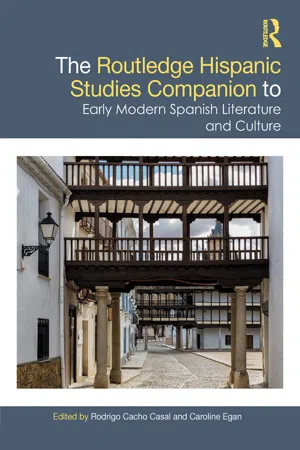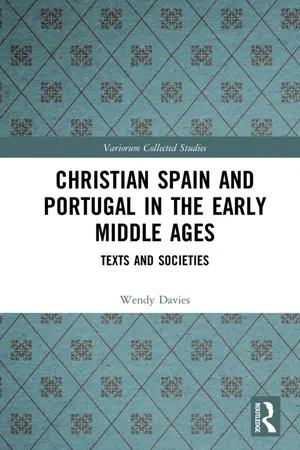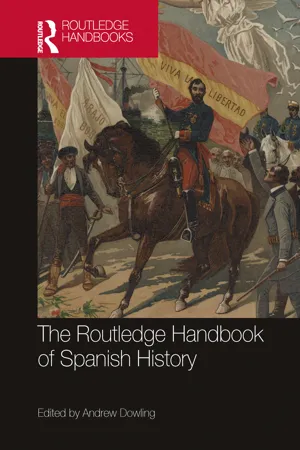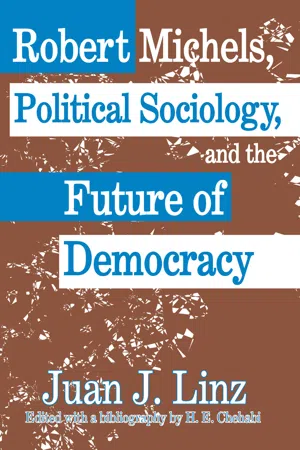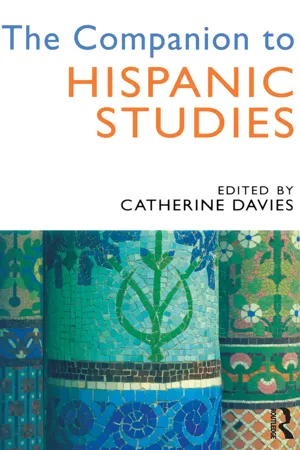History
Early Modern Spain
Early Modern Spain refers to the period from the late 15th century to the early 18th century, characterized by significant political, social, and cultural changes. It saw the unification of Spain, exploration and colonization of the Americas, the Spanish Inquisition, and the rise of a global empire. This era also witnessed the flourishing of Spanish art, literature, and intellectual achievements.
Written by Perlego with AI-assistance
Related key terms
5 Key excerpts on "Early Modern Spain"
- Rodrigo Cacho Casal, Caroline Egan, Rodrigo Cacho Casal, Caroline Egan, Rodrigo Cacho Casal, Caroline Egan(Authors)
- 2022(Publication Date)
- Routledge(Publisher)
Companion makes a significant contribution to overcoming historical simplifications and myths, providing both specialists and non-specialists with a valuable tool to navigate the complex intellectual and academic construction that we call Early Modern Spain.Early modern keywords
In keeping with the rationale of The Routledge Companions to Hispanic and Latin American Studies series, this volume’s purpose is twofold: to introduce the intellectual and artistic breadth of Early Modern Spain and to review the most current critical trends and theoretical discourses concerned with this period. The goal is to bring a range of cutting-edge approaches to bear on key issues across a number of areas: history, politics, literature, science, the visual arts, music, race, faith, and gender. The scholars contributing to this volume are based in institutions spread across the globe, including the United States, Mexico, the United Kingdom, Spain, Portugal, France, Italy, Denmark, Canada, and Germany. Such international representation is matched by the theoretical range of the various chapters which, while keeping with the common goals and objectives of the Companion, offers multiple perspectives and approaches.The essays collected in this volume focus on the sixteenth and seventeenth centuries, a chronological framework that featured the development of the Hapsburg Empire, from Charles I (Charles V, 1516–1566) to Charles II (1665–1700). As already pointed out, this era is usually referred to as the Golden Age, a concept that was coined during the Enlightenment. The preference for ‘early modern’ in the title of this Companion acknowledges that in recent decades, the most innovative approaches to Hispanic culture have exceeded some of the traditional theoretical boundaries evoked by the Golden Age rubric, encompassing a greater range of disciplines and a wider academic horizon, focusing on multidisciplinary studies, and analyzing the global and multicultural ramifications of the Spanish Empire. This is also why this volume has been conceived as a direct cognate of the Companion to Colonial Latin America and the Caribbean- eBook - ePub
Christian Spain and Portugal in the Early Middle Ages
Texts and Societies
- Wendy Davies(Author)
- 2019(Publication Date)
- Routledge(Publisher)
1 THE EARLY MIDDLE AGES AND SPANISH IDENTITYThe middle ages have for a long time been seen as a critical period in the formation of modern Spain.1 The creation, expansion, and consolidation of the Christian kingdoms of the north and of the county of Castile, movements characteristic of the ninth, tenth, and eleventh centuries, are held to lay the basis for the unification of Spain in the sixteenth century, the Spanish Empire and the transmission of Spanish culture overseas. The images of territorial expansion, Christian self-confidence and the settlement of a desert have seemed to be essential to understanding what makes Spain Spain. Indeed, the distinctiveness of Spain was a recurrent preoccupation of Spanish historians in the twentieth century: what made Spain different from the rest of Europe?2 Different it obviously seemed to be, given the strength of continuing cultural contacts with Spanish America and given its civil war, its long period of dictatorship, its particular brand of Catholicism, and its very strong regional identities. For most historians, what made Spain different was the distinctiveness of its medieval past, a past of overt cultural and political conflict between Christians and Moslems, and a past in which the almost total Moslem conquest of 711 was gradually, across many centuries, overturned by the ‘centuries-long frontier struggle between Christians and Moslems’: ‘Reconquest [is the] key to the history of Spain’.3 Indeed, the view is not confined to historians and still colours the way many modern Spaniards think of themselves, even if it is to maintain that Spain is no longer different.41 First published in H. Pryce and J. Watts (eds), Power and Identity in the Middle Ages (Oxford: Oxford University Press, 2007), pp. 68–84.2 A. Castro, The Structure of Spanish History , trans. E. L. King (Princeton: Princeton University Press, 1954), p. 3; C. Sánchez-Albornoz, España; un enigma histórico , 2 vols (Buenos Aires: Editorial Sudamericana, 1956); J. M. Jover, ‘Panorama of current Spanish historiography’, Journal of World History , 6 (1960–61), pp. 1023–38; T. F. Glick, Islamic and Christian Spain in the Early Middle Ages - eBook - ePub
- Andrew Dowling, Andrew Dowling, Andrew Dowling(Authors)
- 2023(Publication Date)
- Routledge(Publisher)
Like in the rest of Europe, Spanish cities and urban population grew overall during the early-modern age. However, the spectacular period of early urban growth, especially in interior Castile and Andalusia from 1450 to 1600 (only outpaced by those that took place in the Low Countries, Italy and Portugal), came to an abrupt halt in the seventeenth century. The period of recovery that followed, in the eighteenth century, fell short of achieving sixteenth-century urbanisation levels, but gave the urban map of Spain its final layout, with the decreasing importance of the central regions, Madrid excepted, in favour of the coastal areas.Urban growth in Castile from the mid-fifteenth and through the sixteenth century – when over 30 cities had 10,000 inhabitants or more, and there was a growing number of medium-small cities – led to the formation of urban networks around major nuclei, such as Valladolid, Segovia, Toledo, and, in the south, Seville, epicentre of American trade and main financial-mercantile hub of the Monarchy, which integrated the regional market of its coastline into the global economy. In the Crown of Aragon, the growth of the urban population was less pronounced, and chiefly limited to the medieval court cities of Zaragoza, Barcelona, Valencia and Palma de Mallorca. The urban map of Spain in the sixteenth century, following a period of agricultural expansion and growth in the manufacturing (textiles), commercial and financial sectors, was also affected by political-institutional decisions. The choice of Madrid as capital of the Spanish Monarchy in 1561 resulted in the city's sudden growth – from 9,000 to over 100,000 inhabitants in little more than half a century – and turned it into a major hub of political and social services, luxury trade, manufacture and redistribution of agrarian rents from its large hinterland.The economic and demographic crisis that began in the late sixteenth century slowed down the pace of urbanisation. Many cities, especially in interior Castile, saw their population stagnate and even fall, and underwent the gradual ruralisation of its urban functions, as a result of a drop in rural migration and the decline of industrial operations and commercial activity in the regional and supra-regional level. The massive sale of urban autonomy statuses (villazgos) opened by the Crown at this time enabled many hamlets and villages to become autonomous villas, but at the cost of leading to recurrent conflict and enormous debts for both the purchasing villas - Juan Linz, Juan Linz(Authors)
- 2017(Publication Date)
- Routledge(Publisher)
8 In the 1820s, Spain lost almost all of its overseas empire. A century of political crises, compounded at the end by bitter social conflicts, led to a deep feeling of decadence by the turn of the twentieth century. No other European nation, except Sweden and Portugal, had such a consciousness of past greatness and present comparative insignificance.In this, the Spanish case is not so different from that of many great non-Western societies and cultures that suffered the impact of European expansion. The question of whether something in the historical personality of Spain was basically incompatible with success in the modern world was as unavoidable as the parallel question was for Ottoman, Arab, or Indian intellectuals. How unlike Spain were England and France? In England, tradition was perceived as a continuous process of transmission of some valid heritage from the past. In France, the French Revolution certainly represented a deep political and cultural crisis, but it did not pose the same problem for the French because France was a successful polity and a vibrant culture both before and after the Revolution. England and France had been great nations in the sixteenth and the eighteenth centuries, respectively; they had suffered ups and downs, but they were still great powers with developing colonial empires in the nineteenth century. In the view of the Spaniards, only Italy had suffered some of the same difficulties in finding a successful place in the modern world. But in Italy the national unification and the enthusiasms created by the Risorgimento gave a sense of hope to the new nation. The success in the modern world of Britain, the United States (which defeated Spain in 1898), and the new imperial Germany (which had defeated France in 1870), made late nineteenth century Spaniards conscious of the question raised by a French book (translated with a foreword by a leading Spanish politician) titled “What makes for the superiority of the Saxons?”9 Certainly, Germans both before and after the 1871 unification also harbored misgivings about the significance of their traditions, and many of them were deeply suspicious of the political innovations emanating from the major liberal/capitalist societies of that time. But for Germans, at least, the subsequent decades saw great cultural creativity. Moreover, the successes of German scientists, businessmen, and armies between 1871 and 1918 could support a sense of pride and nationalism in most people. Even Russia, despite its intelligentsia’s awareness of their country’s economic and, above all, social and political backwardness, provided its people with a sense of mission until 1905. This is well reflected in the political writings of Dostoyevsky and the Slavophiles, who exalted a Russian soul in contrast with the evils they saw in Western civilization. In fact, there are some parallels between the reaction of some Spanish intellectuals to the Western individualistic, secularized, and materialistic civilization and that of the Russians, and some Baltic German exiles from Russia, such as Count Keyserling and Walter Schubart, who also came to see a similarity in the position of these two nations on the fringes of Europe.10- eBook - ePub
- Catherine Davies(Author)
- 2014(Publication Date)
- Routledge(Publisher)
3 Golden Age Studies: Spain and Spanish America in the sixteenth and seventeenth centuries Terence O'ReillyWhat are the challenges facing Golden Age Studies? First, a large number of the texts we need in order to form a clear view of this period remain unstudied. Many survive in printed form, but have not been examined closely in modern times; many more are still in manuscript; most have yet to be reproduced in trustworthy critical editions. And secondly, interpretation of the texts we do know has been bedevilled by modern controversies about three events that shaped the Golden Age: (1) the unification of the Iberian kingdoms around Castile, (2) the conquest and colonisation of the New World, and (3) resistance within Spain to certain aspects of the European Renaissance and Reformation. At the time of the Spanish Civil War and in its aftermath, these events were viewed positively, on the whole, by Franco's Nationalists, who found in them models to imitate, but negatively by Republicans, for whom they signified an erosion of freedom, Strange as it may seem, both sides sought in the Golden Age the origins of the conflict in which they were involved. But since the death of Franco the situation has changed. The task of editing texts, known and unknown, has been energised by a new generation of scholars. In a stream of studies, both historical and literary, many of our received notions about the period have been rethought. These studies have also underlined a basic truth: the literature of the Golden Age is informed by a mentality very different from our own. To read it with understanding, therefore, we must be sensitive to its otherness, otherwise we shall find in it no more than a reflection of our own concerns.Unity and Diversity
The Golden Age witnessed the ascendancy of Castile, especially in the century before 1580 (see Chapter 2 ), when the medieval kingdoms of Iberia came together as a political unit, namely la monarquía española
Index pages curate the most relevant extracts from our library of academic textbooks. They’ve been created using an in-house natural language model (NLM), each adding context and meaning to key research topics.
